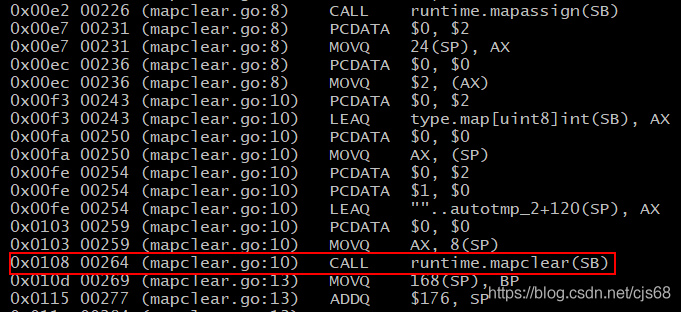Golang 空map和未初始化map的註意事項說明
可以對未初始化的map進行取值,但取出來的東西是空:
var m1 map[string]string fmt.Println(m1["1"])
不能對未初始化的map進行賦值,這樣將會拋出一個異常:
panic: assignment to entry in nil map
var m1 map[string]string m1["1"] = "1"
通過fmt打印map時,空map和nil map結果是一樣的,都為map[]。所以,這個時候別斷定map是空還是nil,而應該通過map == nil來判斷。
補充:Golang清空map的兩種方式及性能比拼
一、Golang中刪除map的方法
1、所有Go版本通用方法
a := make(map[string]int) a["a"] = 1 a["b"] = 2 // clear all a = make(map[string]int)
2. Go 1.11版本以上用法
通過Go的內部函數mapclear方法刪除。這個函數並沒有顯示的調用方法,當你使用for循環遍歷刪除所有元素時,Go的編譯器會優化成Go內部函數mapclear。
package main
func main() {
m := make(map[byte]int)
m[1] = 1
m[2] = 2
for k := range m {
delete(m, k)
}
}
把上述源代碼直接編譯成匯編(默認編譯是會優化的):
go tool compile -S map_clear.go
可以看到編譯器把源碼9行的for循環直接優化成瞭mapclear去刪除所有元素。如下:

再來看看關閉優化後的結果:
go tool compile -l -N -S map_clear.go
關閉優化選項後,Go編譯器直接通過循環遍歷來刪除map裡面的元素。

具體的mapclear代碼可以在go源碼庫中runtime/map.go文件中看到,代碼如下:
// mapclear deletes all keys from a map.
func mapclear(t *maptype, h *hmap) {
if raceenabled && h != nil {
callerpc := getcallerpc()
pc := funcPC(mapclear)
racewritepc(unsafe.Pointer(h), callerpc, pc)
}
if h == nil || h.count == 0 {
return
}
if h.flags&hashWriting != 0 {
throw("concurrent map writes")
}
h.flags ^= hashWriting
h.flags &^= sameSizeGrow
h.oldbuckets = nil
h.nevacuate = 0
h.noverflow = 0
h.count = 0
// Keep the mapextra allocation but clear any extra information.
if h.extra != nil {
*h.extra = mapextra{}
}
// makeBucketArray clears the memory pointed to by h.buckets
// and recovers any overflow buckets by generating them
// as if h.buckets was newly alloced.
_, nextOverflow := makeBucketArray(t, h.B, h.buckets)
if nextOverflow != nil {
// If overflow buckets are created then h.extra
// will have been allocated during initial bucket creation.
h.extra.nextOverflow = nextOverflow
}
if h.flags&hashWriting == 0 {
throw("concurrent map writes")
}
h.flags &^= hashWriting
}
二、兩種清空map方式性能比較
1、先用benchmark的方式測一下兩種方式
benchmark代碼如下:
func BenchmarkMakeNewMap(b *testing.B) {
tmpMap := make(map[string]string, 10000)
for i := 0; i < b.N; i++ {
for j := 0; j < 10000; j++ {
tmpMap["tmp"+strconv.Itoa(j)] = "tmp"
}
tmpMap = make(map[string]string, 10000)
}
}
func BenchmarkDeleteMap(b *testing.B) {
tmpMap := make(map[string]string, 10000)
for i := 0; i < b.N; i++ {
for j := 0; j < 10000; j++ {
tmpMap["tmp"+strconv.Itoa(j)] = "tmp"
}
for k := range tmpMap {
delete(tmpMap, k)
}
}
}
得到測試結果如下:

從測試結果上看,好像確實delete的方式效率更高,但是這個benchmark中總感覺沒有測試到真正清空map的地方,中間穿插著put map的操作,我們用方法2再測一下。
2、單個UT測一下兩種方式
UT代碼如下:
測試過程中禁用瞭gc,避免gc對運行時間和內存產生幹擾。
func TestMakeNewMap(t *testing.T) {
debug.SetGCPercent(-1)
var m runtime.MemStats
tmpMap := make(map[string]string, 1000000)
for j := 0; j < 1000000; j++ {
tmpMap["tmp"+strconv.Itoa(j)] = "tmp"
}
start := time.Now()
tmpMap = make(map[string]string, 1000000)
fmt.Println(time.Since(start).Microseconds())
runtime.ReadMemStats(&m)
fmt.Printf("%d Kb\n", m.Alloc/1024)
}
func TestDeleteMap(t *testing.T) {
debug.SetGCPercent(-1)
var m runtime.MemStats
tmpMap2 := make(map[string]string, 1000000)
for j := 0; j < 1000000; j++ {
tmpMap2["tmp"+strconv.Itoa(j)] = "tmp"
}
start := time.Now()
for k := range tmpMap2 {
delete(tmpMap2, k)
}
fmt.Println(time.Since(start).Microseconds())
runtime.ReadMemStats(&m)
fmt.Printf("%d Kb\n", m.Alloc/1024)
}
測試結果如下:

從測試結果上看,好像確實是make方式的效率更低,而且內存占用更多,但結果真的是這樣嗎?
我們把make方式的make map的大小改為0再試一下:
tmpMap = make(map[string]string)
得到如下結果,What?時間為0瞭,內存消耗也跟delete的方式一樣:

我們把make方式的make map的大小改為10000再試一下:
tmpMap = make(map[string]string, 10000)
結果如下:

三、總結
通過上面的測試,可以得出結論:
1、在map的數量級在10w以內的話,make方式會比delete方式速度更快,但是內存會消耗更多一點。
2、如果map數量級大於10w的話,delete的速度會更快,且內存消耗更少。
3、對於不再使用的map,直接使用make方式,長度為0清空更快。
以上為個人經驗,希望能給大傢一個參考,也希望大傢多多支持WalkonNet。如有錯誤或未考慮完全的地方,望不吝賜教。